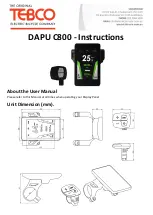
..............
..............
6
7
...........................................................................................................................................................................................................................
Pedals
Chain
Main Frame Clamp
Chainset
Bottle Cage Bosses
Headset
Front Suspension
Brake Lever
Grip Shifter
Handlebar
Mesh Seat
Rear Suspension
Rear Derailleur
Elastomer
Chain Tube
Hinge Release Lever
Front Derailleur
i
TIP:
Experiment but always go for a
reasonable (a mile or two) test ride
to decide if an adjustment is right for
you.
1.2 Adjusting and closing quick-releases
Quick-releases are used in a number of places
on your trike; it is important that they are
tightened correctly. A quick-release that isn’t
fully and properly closed can result in parts
coming loose or moving while riding. This could
cause a serious accident. A quick-release
system consists of two basic parts: a lever that
provides the clamping force and an adjusting
nut that alters the clamping tension.
With the part you are clamping located
properly, adjust the quick-release by opening
it, holding both ends and turning one clockwise
until, when you close the lever, you feel some
resistance. At this point, try to close the lever
fully. The adjustment is correct when you can
fully close the lever, but with some effort (the
lever should leave its impression in the palm of
your hand).
If you can only close the lever part way, open
it, unscrew the adjusting nut slightly and try
again. If it closes too easily, tighten it up a tiny
bit and try again. Do not try to tighten the quick-
release by winding the lever around; it will not
tighten enough to be safe.
i
2.0 Adjusting your ICE trike
TIP:
When assembling your trike,
please refer to the table in the
appendix for the proper tightening
torques for all fasteners. Do not
overtighten.
Fine-tuning for leg length, seat angle, handle
bar width / angle, brake lever reach, tyre
pressure etc are all well worth taking time to
set to your personal preference.
1.0 Introduction
We hope you enjoy owning and riding your ICE
trike as much as we like making these great
machines.
On the off-chance that you have any issues with
your trike please contact your dealer or ICE HQ.
(see contact details on page 37)
1.1 Overview
Congratulations on being a new ICE trike owner.
You have purchased the finest, most refined
recumbent tricycle available today; we hope it
brings you many years of enjoyment.
This manual has been written to help you set up
and use your trike. Recumbent trikes may be
a little different from the cycles you are familiar
with, so please take a moment to read through
this document. You will find the latest version of
this manual in a download-able PDF format on
our website.
Throughout the manual, we have included
some tips, which have been learned from over
20 years of experience building trikes. They are
well worth taking special note of.
If you have never worked on a bike before,
you should consider purchasing a good book
on bicycle maintenance. The ICE trikes use as
many standard bicycle components as possible,
and their adjustment and maintenance is no
different from an upright bicycle.
We can recommend Lennard Zinn’s
“Zinn and the Art of Mountain Bike Maintenance”
as a thorough and easy-to-read reference.
If you are assembling your trike for the first time,
please refer to the ICE Trikes Assembly Manual.
ICE Sprint FS used in this example.
ICE Philosophy Film
www.youtube.com/icetrikes




































